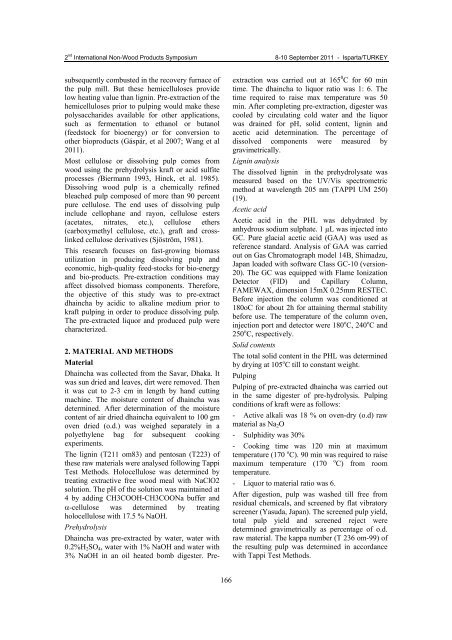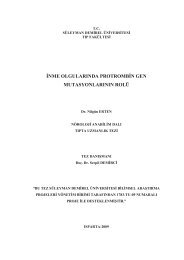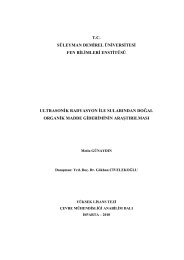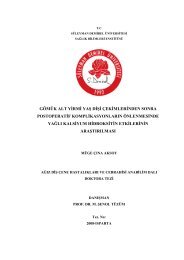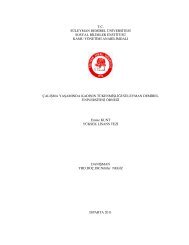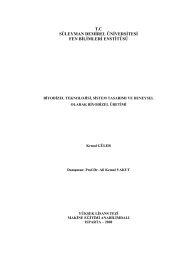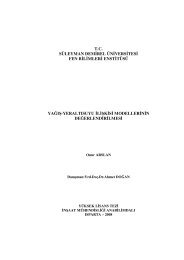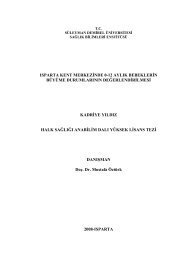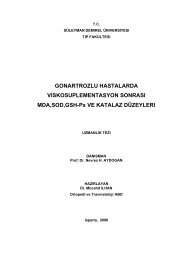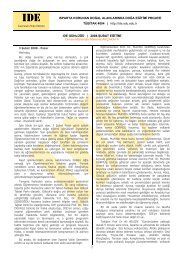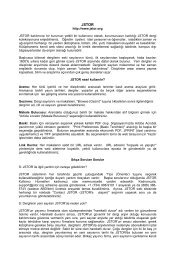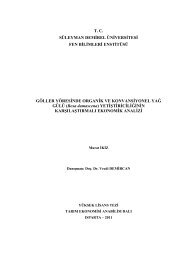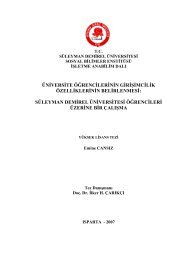Proceedings Book / Bildiri Kitabı - Orman Fakültesi - Süleyman ...
Proceedings Book / Bildiri Kitabı - Orman Fakültesi - Süleyman ...
Proceedings Book / Bildiri Kitabı - Orman Fakültesi - Süleyman ...
You also want an ePaper? Increase the reach of your titles
YUMPU automatically turns print PDFs into web optimized ePapers that Google loves.
2 nd International Non-Wood Products Symposium 8-10 September 2011 - Isparta/TURKEY<br />
subsequently combusted in the recovery furnace of<br />
the pulp mill. But these hemicelluloses provide<br />
low heating value than lignin. Pre-extraction of the<br />
hemicelluloses prior to pulping would make these<br />
polysaccharides available for other applications,<br />
such as fermentation to ethanol or butanol<br />
(feedstock for bioenergy) or for conversion to<br />
other bioproducts (Gáspár, et al 2007; Wang et al<br />
2011).<br />
Most cellulose or dissolving pulp comes from<br />
wood using the prehydrolysis kraft or acid sulfite<br />
processes (Biermann 1993, Hinck, et al. 1985).<br />
Dissolving wood pulp is a chemically refined<br />
bleached pulp composed of more than 90 percent<br />
pure cellulose. The end uses of dissolving pulp<br />
include cellophane and rayon, cellulose esters<br />
(acetates, nitrates, etc.), cellulose ethers<br />
(carboxymethyl cellulose, etc.), graft and crosslinked<br />
cellulose derivatives (Sjöström, 1981).<br />
This research focuses on fast-growing biomass<br />
utilization in producing dissolving pulp and<br />
economic, high-quality feed-stocks for bio-energy<br />
and bio-products. Pre-extraction conditions may<br />
affect dissolved biomass components. Therefore,<br />
the objective of this study was to pre-extract<br />
dhaincha by acidic to alkaline medium prior to<br />
kraft pulping in order to produce dissolving pulp.<br />
The pre-extracted liquor and produced pulp were<br />
characterized.<br />
2. MATERIAL AND METHODS<br />
Material<br />
Dhaincha was collected from the Savar, Dhaka. It<br />
was sun dried and leaves, dirt were removed. Then<br />
it was cut to 2-3 cm in length by hand cutting<br />
machine. The moisture content of dhaincha was<br />
determined. After determination of the moisture<br />
content of air dried dhaincha equivalent to 100 gm<br />
oven dried (o.d.) was weighed separately in a<br />
polyethylene bag for subsequent cooking<br />
experiments.<br />
The lignin (T211 om83) and pentosan (T223) of<br />
these raw materials were analysed following Tappi<br />
Test Methods. Holocellulose was determined by<br />
treating extractive free wood meal with NaClO2<br />
solution. The pH of the solution was maintained at<br />
4 by adding CH3COOH-CH3COONa buffer and<br />
-cellulose was determined by treating<br />
holocellulose with 17.5 % NaOH.<br />
Prehydrolysis<br />
Dhaincha was pre-extracted by water, water with<br />
0.2%H 2 SO 4 , water with 1% NaOH and water with<br />
3% NaOH in an oil heated bomb digester. Preextraction<br />
was carried out at 165 0 C for 60 min<br />
time. The dhaincha to liquor ratio was 1: 6. The<br />
time required to raise max temperature was 50<br />
min. After completing pre-extraction, digester was<br />
cooled by circulating cold water and the liquor<br />
was drained for pH, solid content, lignin and<br />
acetic acid determination. The percentage of<br />
dissolved components were measured by<br />
gravimetrically.<br />
Lignin analysis<br />
The dissolved lignin in the prehydrolysate was<br />
measured based on the UV/Vis spectrometric<br />
method at wavelength 205 nm (TAPPI UM 250)<br />
(19).<br />
Acetic acid<br />
Acetic acid in the PHL was dehydrated by<br />
anhydrous sodium sulphate. 1 µL was injected into<br />
GC. Pure glacial acetic acid (GAA) was used as<br />
reference standard. Analysis of GAA was carried<br />
out on Gas Chromatograph model 14B, Shimadzu,<br />
Japan loaded with software Class GC-10 (version-<br />
20). The GC was equipped with Flame Ionization<br />
Detector (FID) and Capillary Column,<br />
FAMEWAX, dimension 15mX 0.25mm RESTEC.<br />
Before injection the column was conditioned at<br />
180oC for about 2h for attaining thermal stability<br />
before use. The temperature of the column oven,<br />
injection port and detector were 180 o C, 240 o C and<br />
250 o C, respectively.<br />
Solid contents<br />
The total solid content in the PHL was determined<br />
by drying at 105 o C till to constant weight.<br />
Pulping<br />
Pulping of pre-extracted dhaincha was carried out<br />
in the same digester of pre-hydrolysis. Pulping<br />
conditions of kraft were as follows:<br />
- Active alkali was 18 % on oven-dry (o.d) raw<br />
material as Na 2 O<br />
- Sulphidity was 30%<br />
- Cooking time was 120 min at maximum<br />
temperature (170 o C). 90 min was required to raise<br />
maximum temperature (170<br />
o C) from room<br />
temperature.<br />
- Liquor to material ratio was 6.<br />
After digestion, pulp was washed till free from<br />
residual chemicals, and screened by flat vibratory<br />
screener (Yasuda, Japan). The screened pulp yield,<br />
total pulp yield and screened reject were<br />
determined gravimetrically as percentage of o.d.<br />
raw material. The kappa number (T 236 om-99) of<br />
the resulting pulp was determined in accordance<br />
with Tappi Test Methods.<br />
166


